Sony Alpha A6000 – World’s fastest AF – Part 2
I made few initial AF tests in one of my previous posts – click here, and I promised to make more tests to see if I can come to some conclusion…Meanwhile I saw and received few rude and disrespectful comments, mainly from anonymous people who probably misunderstood my original intention.But let me try to explain once more, what and why I am trying to find out…- I don’t care about Sony, Nikon, Canon or other producers. I paid for my equipment full price and I have no sentiment or any kind of relation to any of the camera or lens producer. In other words, in this A6000 AF posts, I have no other agenda than trying to see, what new AF system is really capable of, and what settings would work better in different situations.- I am working in advertising all my life, and I know the power of the advertising campaign. Is it fair? No. Can I change the world of advertising? No. Can I try to add a bit of objectivity to balance those powerful claims, if I see the opportunity? I hope so.- When I wrote that I am not frequent AF user, it doesn’t mean that I don’t know how to use it. Reason why I am not using it often, is that I shot MF lenses mostly, and my main subjects are products and studio-portraits. That is part of my paid work. My hobby is landscape and little bit of the street style. None of those require AF.
– I am not attracted by BIF, but it doesn’t mean that I can’t shot them. If you want to see few of my sharp photos of BIF you can check this small set – here. I can hardly differ between pigeon and seagull, though.
If you want to challenge my AF skills more, few Air-show shots are – here and few action shots are – here.
But than again, there are situations, where AF will be of little use and I find myself more often in those situations.
– Finally – I wrote at the very beginning of my little blog adventure, that English is not my first, not even second language. I am well aware of the fact, that my posts are full of mistakes, but I still believe that most of it, could be properly interpreted.
I had to make this self promoting introduction, because most of the rude comments that I saw or received, related to my original post, were referring to my absolute incompetence to use AF or test equipment. Sure. Keep shooting your back yard wildlife and look somewhere else please.
Apologize to those, who added something constructive in their comments, offered to participate in further testing and in general, treat Internet as a place for discussion and not arguing fan-boys arena.
Following post is only for you 🙂
Testing AF…
While most of the comparison tests (of cameras, or lenses, or even cars) are usually flawed a bit, there is still good base to get some use of them. By base I mean methodology, that should somehow equal the conditions for comparison and make sense to the conclusion.
Doing same for AF performance, is in general a bit more tricky. There are too many variables involved, to make some reasonable comparison between cameras of the same producer, not to speak about comparison across the systems.
I have seen very few valuable AF tests overall, (and this one is not going to be anywhere close to those few), but lot of praising or bashing of the AF systems, based on the photographers experience. That makes most AF tests related to the authority of the tester, which on the other hand, leaves open question about their relation with producers.
Here are just few of those above mentioned variables that comes to my mind – Lens AF speed, lighting conditions, ability of the tested subject to repeat movement several times, type of the lens (tele-wide), speed (aperture) of the lens, DOF related to the FL, and lens speed, operator errors, different camera settings and so on…
The last one – camera settings, was (and still is) my main critique to Sony, for not providing thorough user manual, explaining in detail how their AF settings works and interact together.
Using (typical) DSLR, makes settings and their understanding easier, because we have to deal with one system in time – PDAF for most situation, or CDAF for some Live View modes. I said typical, because there are some DSLRs, with hybrid systems involved too, but I never owned or tried any of those (Canon EOS 70D e.g.)
Sony A6000 has hybrid AF system. According to Sony, phase detection sensors, planted on the image sensor are responsible for the fast AF adjustment, while Contrast detection is supposed to take care of fine tunning.
Let me quote Sony official specification of the AF system (Link):
- Focus Control
- Focus Features : Lock-on AF, Eye AF, Predictive control, Focus lock, AF illuminator (with Built-in LED type) Approx. range; 0.3- approx. 3.0m (with E PZ 16-50mm F3.5-5.6 OSS lens attached)
- AF Illuminator : Built-in LED, Range: approx. 3′ 4” – 9′ 9” (0.3m-3.0m)
- Focus Sensitivity : EV0 to EV20 (ISO100 equivalent with F2.8 lens attached)
- Focus Area : Wide (179 points phase-detection AF, 25 points contrast-detection AF), Zone, Center-weighted, Flexible Spot (Small, Medium, Large)
- Focus Points : 179 points (phase-detection AF) 25 points (contrast-detection AF)
- AF Modes : AF-A (Automatic AF), AF-S (Single-shot AF), AF-C ( Continuous AF), DMF (Direct Manual Focus), Manual Focus
- Focus System : Fast Hybrid AF(phase-detection AF/contrast-detection AF)
Beside repeating few things in their own specification (which doesn’t help in description – does it?), I will be really happy if someone can decode it for the normal people, to let them understand, what focus mode or feature they should use in which situation.
Here is one example for all…
In my several efforts to test different AF modes and features (using Sony terminology), I think (but I am not sure) that Lock-On AF is using only Contrast detection AF. What I also can’t clearly understand is how Lock-on AF is dependent on the selected AF area.
You will see, that no matter what AF area is selected, lock-on square (that changes its size and shape deliberately it seems), will move all around, and only when the subject is lost, AF area will be switched to the originally set one.
Sounds complicated? It’s even worse than that, because I still haven’t take into consideration AF features – Eye AF, Face/Smile detection etc. If you are asking – what is that AF feature in the specification called – predictive AF, I guess it is related to the possibility to set pre-AF (active AF prior to pressing shutter button), but it can also be related to one of two Lock-on AF activation modes.
Many people bought and plan/will buy this camera because of the promoted super fast AF. They will probably switch the camera to iAUTO and try to shot their running kids, dogs or BIF. They might be successful, but doing similar settings to the scene “sport” mode in my previous post, I was disappointed with results.
When we speak about AF tracking, we might speak about two different things actually:
a) AF tracking of the subject that we are trying to keep in the selected AF zone by panning with the camera. This is in fact – Continuous AF (C-AF), and the success of the resulting focus will be highly dependable on our own tracking skills.
b) AF tracking within selected AF area, without moving the camera, where different AF points (linked to the AF sensors) are engaged to keep focus on the moving subject. In Sony world, this is Lock-On AF feature.
With most DSLRs that I have been using, settings were much simpler, because there was phase detection AF used in most situation. All I had to do is to select the AF area, than to find the subject within AF area, lock the focus by half-pressing the shutter button, and let AF sensors (within selected area), do the rest). (Of course, in more sophisticated cameras, such as Canon Pro bodies, there are many other settings, but there are very logical and with Canon published support, it is easy to understand which function does what and how they are related to each other).
Now, if you leave Sony Focus Area in Wide or Zone, you will be able to see (if selected) little green squares dancing around your subject (or more often somewhere else), indicating the focus points (groups of focus sensors) that are active. But, if you select Flexible Spot, you will be able to see only that one square and you don’t really know what AF points (within that flexible spot square are engaged). That would still be OK (at the end of the day, why should we care about which points are engaged), as long as our Flexible Spot square covers the subject, right?
Well, not so fast…
There are many reasons why we would like to know which exactly AF point is engaged, because even the smallest flexible spot is still wide enough to have few of those AF points inside, and if we want to have right eye of our lovely model or eyes of motorcycle racer wearing the helmet in critical focus, without knowing more precise where single active AF point is, our effort might fail.
That’s where Eye AF should come in right? Maybe, in the single shot, if our model stays still (and looks like human). That won’t help us in the C-AF mode.
Last but not least – if I select that Lock-On AF in any of the “focus area” modes, a little double stroked something (square that changes size and shape upon its own mind) will appear and all other AF display animations will be override, in the moment you press the middle control button to lock-on AF.
That little Lock-On AF something have also two modes – Lock-On AF and Lock-On AF with shutter press. I am yet to test the second option, but with the first option, you should find your subject within that little something and then press middle control button to lock AF on it. Little something will than change to green, telling you that AF is locked.
My question is – when Lock-On AF is confirmed, how it is related to the selected AF area and does it use Phase Detection AF or Contrast Detection?
You see, with most DSLRs that I have been working with, when I select focus zone, I am telling the camera which AF points to keep active to cover my subject if it falls out of my main AF point.
With Sony I can either select:
1. Wide or Zone AF – without possibility to select single AF point (and as a result, usually get AF on something else than my subject, unless I shot BIF against the sky). (There is also center weighted area that I have yet to try, but what is different from the zone focus (placed in the center) only Sony knows.)
2. Or I can use Flexible spot in three sizes, but if my selected size is too small, I will have hard time to keep it on my moving subject, and if it is too large, I have no control on the focus points inside and thus it can be fooled with something around.
3. Or I can combine any of the above zones with the feature Lock-On AF, but than I completely lost the idea of not only which AF point is used, but also which AF method is used…
I have tried all, but before I show you my results, let me just say few words about lenses…
As I wrote in my last post – what sense does fastest AF camera in the world make, without fastest AF lens? And that one is still not in the Sony offer (on my local market). Testing AF with WA lenses doesn’t make much sense to me, but I bet that due to much larger DOF, results will be… much better.
I am waiting for the FE 70-200 f/4 OSS to come, and while I am not excited about its speed and price, I will buy it for testing.
Meanwhile I still used two longest lenses that I own – SEL 55-210 (with the latest firmware) and FE 55/1.8.
1. Wide and Zone focus with Lock-On AF set to Off.
Here are results of my effort to keep running Max in focus using Zone and Wide focus. Actually, here is only wide, because Zone, was total failure. Little green points were dancing all around my subject, and no matter what zone I selected, it kept ignoring Max for whatever reason…
This is how scene looked like.
Max was standing behind and started to run toward camera on my command. My camera (actually two cameras, because I recorded some video too) were on the tripod with the ball head at low friction, that allowed me to pan with the camera, while preventing camera shake (mostly).
Here are 100% crops from this effort:
Next to the each 100% crop, there is screen shot from the LCD of A6000, showing where approx. camera placed those AF points. I am sorry for the reflections in the LCD that makes observation harder (I will get rid of it next time), but clicking on the original image, you should be able to get the idea.
Here is also link to the video documenting this effort – Area Wide, No Lock-on AF.
As you can see from the above, camera was somehow able to cope with the subject at the beginning, but completely lost the idea of what to focus on with Max coming closer.
2. Flexible spot (large) focus area, with Lock-On AF set to Off.
This was best setting for this situation and results are very encouraging…
Here is a link to the video documenting this effort – Flexible Spot (Large) No Lock-On AF
It isn’t perfect, but it is very good, and much better result than any other mirror-less camera that I had chance to try. Considering that this was shot with the budget and slow SEL 55-210 f/4.5-6.3 OSS lens, results are really promising and I am looking forward to repeat the test, with serious AF lens, such as FE 70-200 f/4 OSS should be.
It will be easier to see limitations of this set-up in comparison to Canon 1D Mark III with EF 70-200 f/2.8 L IS II in the similar setup:
And directly compared 100% crops:
I choose Canon 1D Mark III, because it can be found used for the similar price like new A6000 and it is still very capable action camera. But the main difference here are in the used lenses, so let’s see how this comparison will end, when I finally got my FE 70-200 f/4 OSS to try.
Following tests are trying to figure out, how that Lock-On AF feature works…
This is my second setup
3. Zone focus area, with Lock-On AF set to On.
I decided to shot only JPEG fine (Clear) Picture Style for this settings and that was probably mistake. Due to the aggressive Sony JPEG compression, most of images looks like over-sharpened crap to me, but it is what it is… Next time only RAW as usual.
While my subject was further from camera, focus was OK as far as I can tell from that JPEG blotchy detail. When he gets closer to the camera, situation changed…
I spent quite some time, evaluating critical sharpness in that JPEG mess, and I used green (good) and red (failed) dots to express when sharpness was OK and when it wasn’t. Apart from the start of that sequence, you can see kind of pattern in the AF behavior – two shots good, two shots bad, that good again. This is typical for the CDAF behavior and it is main reason why I believe that Lock-On AF is actually using Contrast Detection AF to follow the subject. It might work also in some loops – CDAF – PDAF – CDAF e.g. but without Sony explanation, I doubt that we will ever find it.
Oh, not to forget, I used FE 55/1.8 ZA for those tests.
Here is a link to the video documenting this effort – Zone Focus Area, Lock-On AF
4. Flexible Spot (Large) focus area, with Lock-On AF set to On.
Finally, I tried to use Lock-On AF in combination with the Flexible Spot. As you would see from the results and from enclosed video, it didn’t make much difference IMHO.
Here is a link to the video documenting this effort – Zone Focus Area, Lock-On AF
What is my conclusion?
There is not any yet… I need to get FE 70-200 f/4 OSS first to be able to exclude lens AF speed and optical qualities as a possible reason for blurriness.
I haven’t tried SEL 18-55 nor any other lens (I don’t have any PZ as I wouldn’t use them normally), which is probably pity, because most of the potential owners of A6000 will use SEL 16-50 I believe.
Generally speaking, AF is vastly improved in comparison to any other E-mount camera as of today. No arguing about that.
But is it the fastest AF in the world?
To be honest, I have no idea… Maybe with some lens at certain settings and certain circumstances.
What I know however is that, if action photography will be my main occupation, I will either go with some used pro or semi pro DSLR or learn to focus manually.
A6000 AF seems too sophisticated (and Sony doesn’t help with instruction manual support) and unpredictable in many situations.
If you rely on AF and have or want A6000, don’t be discouraged, just don’t expect that it will make every shot sharp, right out of the box, as you might get impression from the advertising around. Take your time to test different settings, and learn about related AF behavior.
I acquired best results (for the action shots) with following (AF related) settings:
AF mode – C-AF
AF area – Flexible spot (smaller the size that you can keep on your subject, better results to be expected).
Lock-On AF – Off
(Face/Smile/Eye detection all Off).
All your comments (except rude ones) are very welcomed.
Forgive me that I am not able to respond on emails any more.
Please help support this page and upcomming reviews and buy through affiliate links, with no extra cost for you:
Buy on BHPhoto: Alpha a6000 Mirrorless Digital Camera Body (Black)
Buy on Amazon: Alpha a6000 Mirrorless Digital Camera Body (Black)
To help this page survive, your donation will be highly appreciated.
![]()

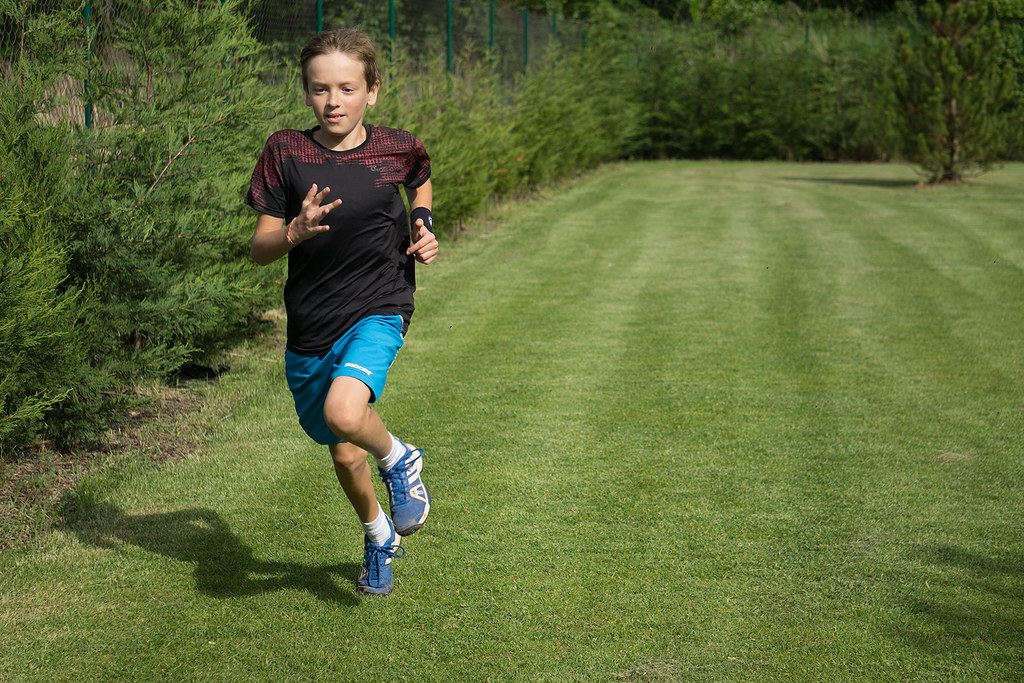
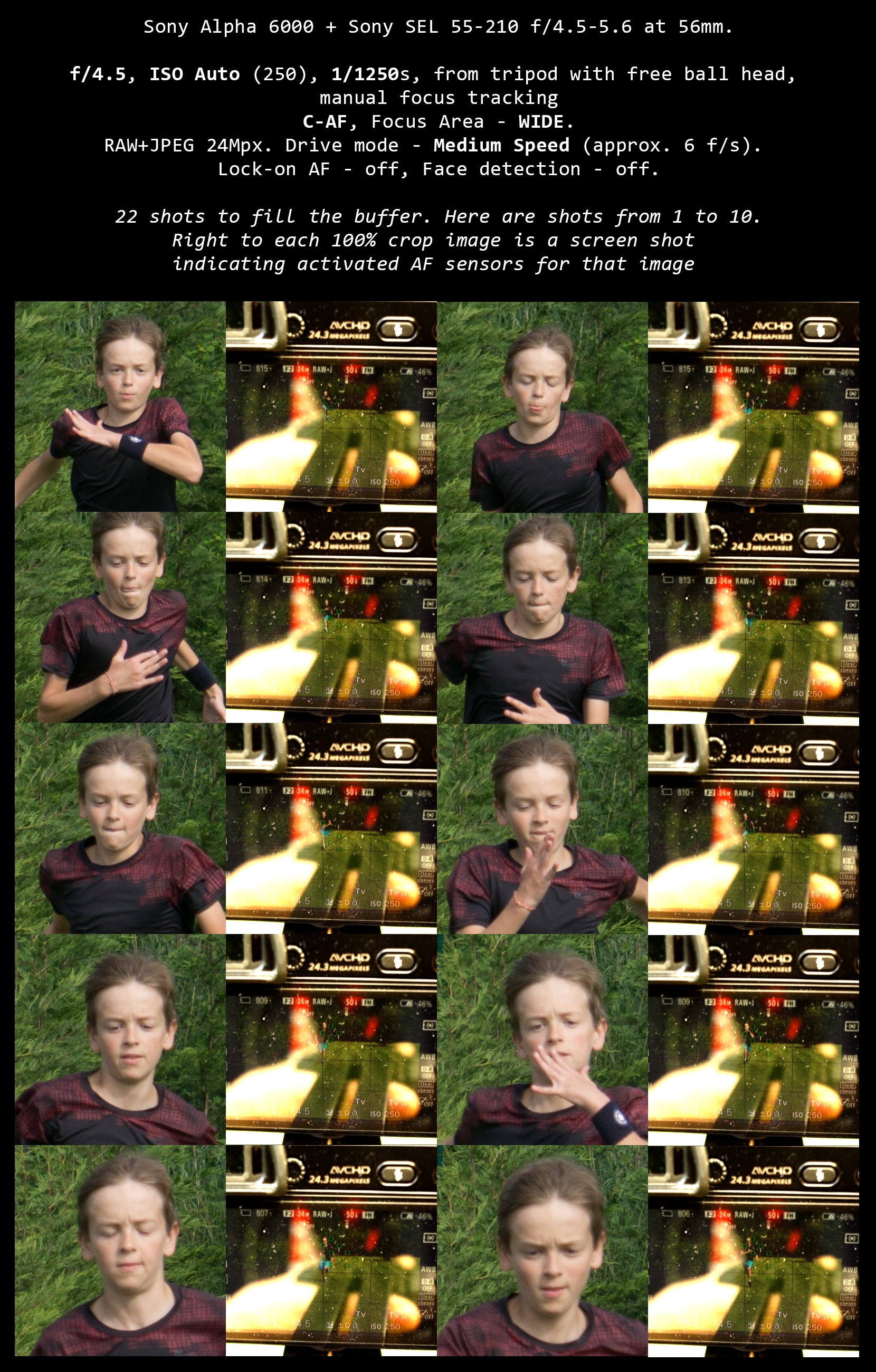
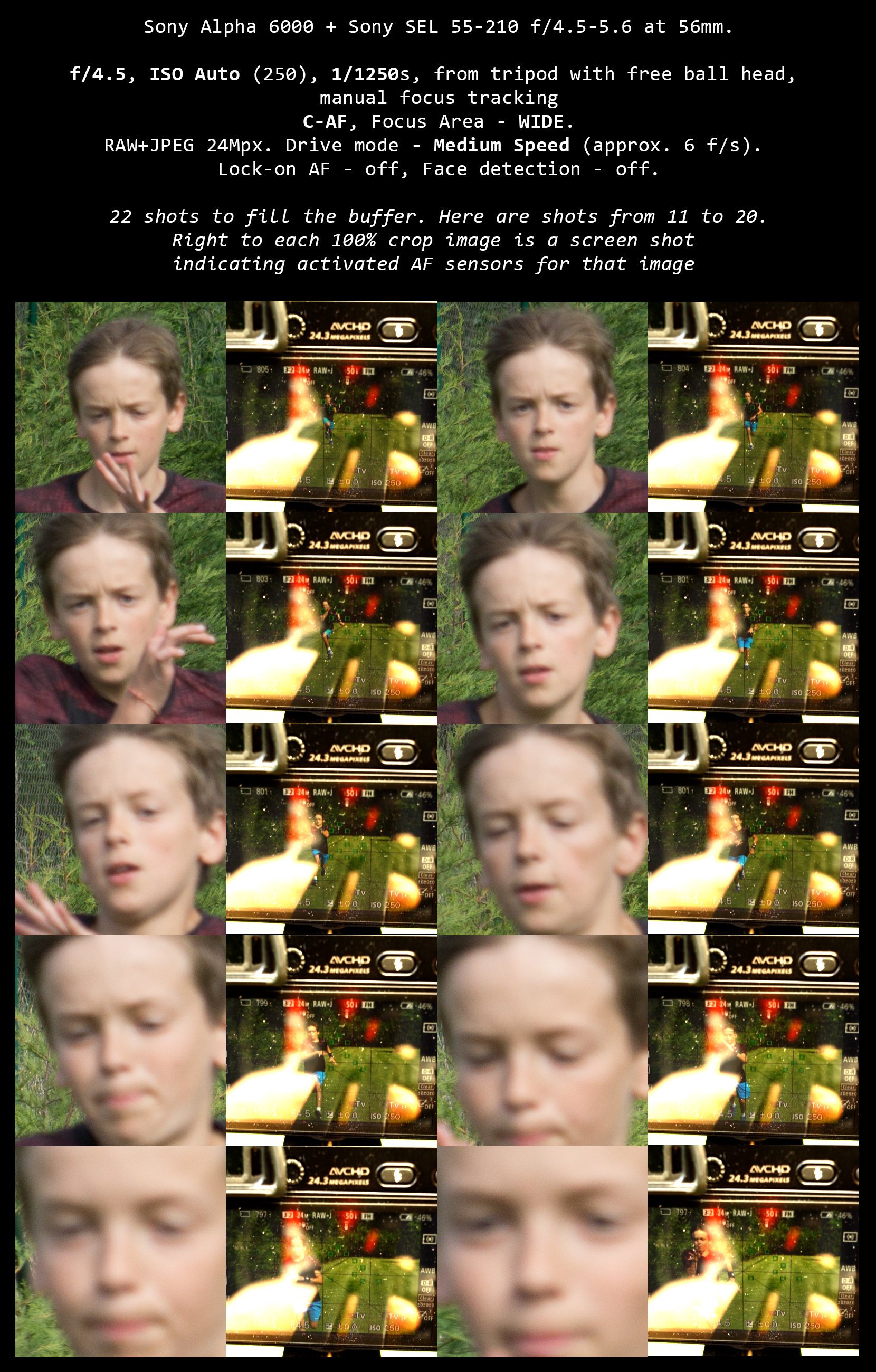

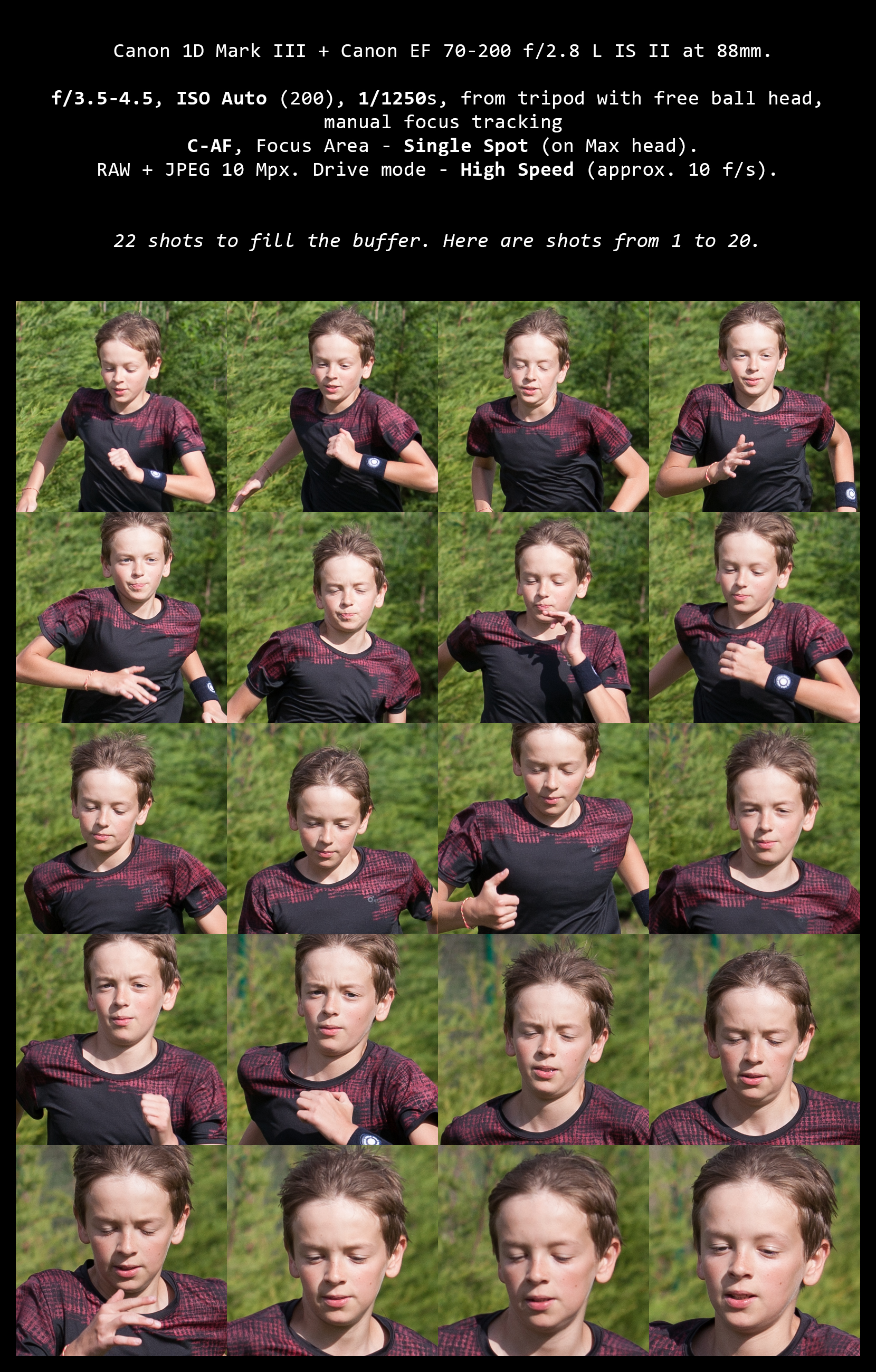



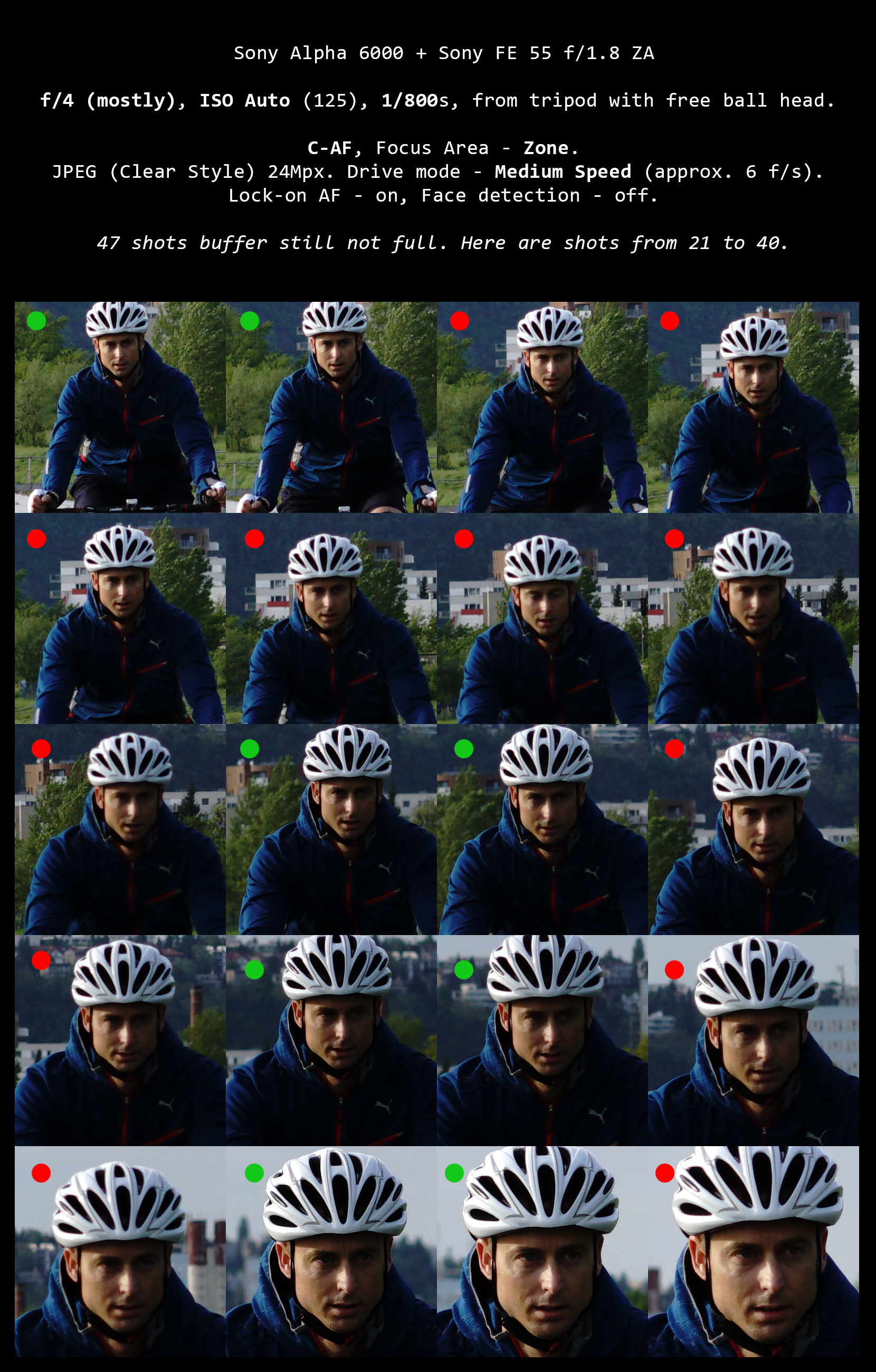
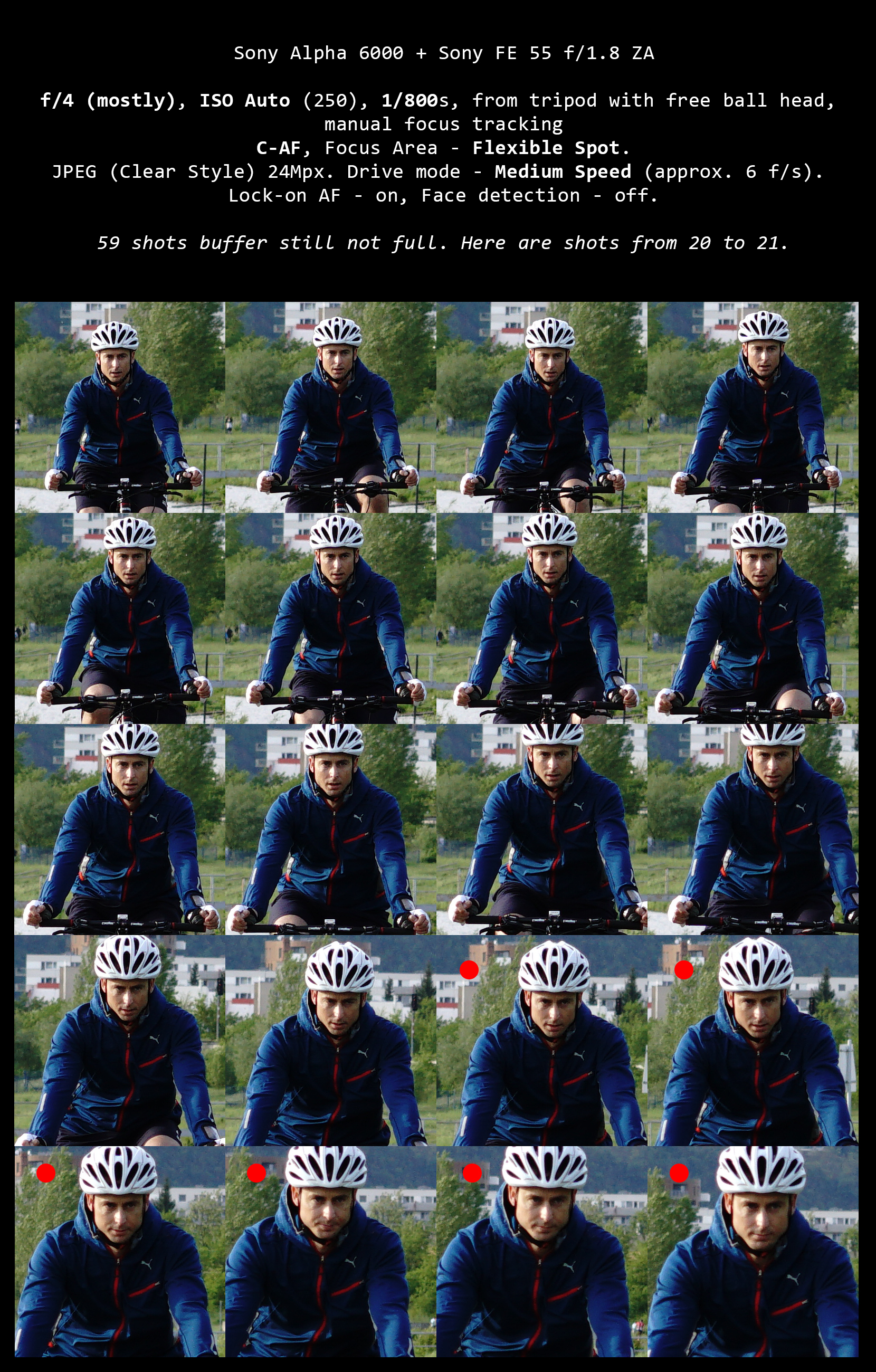
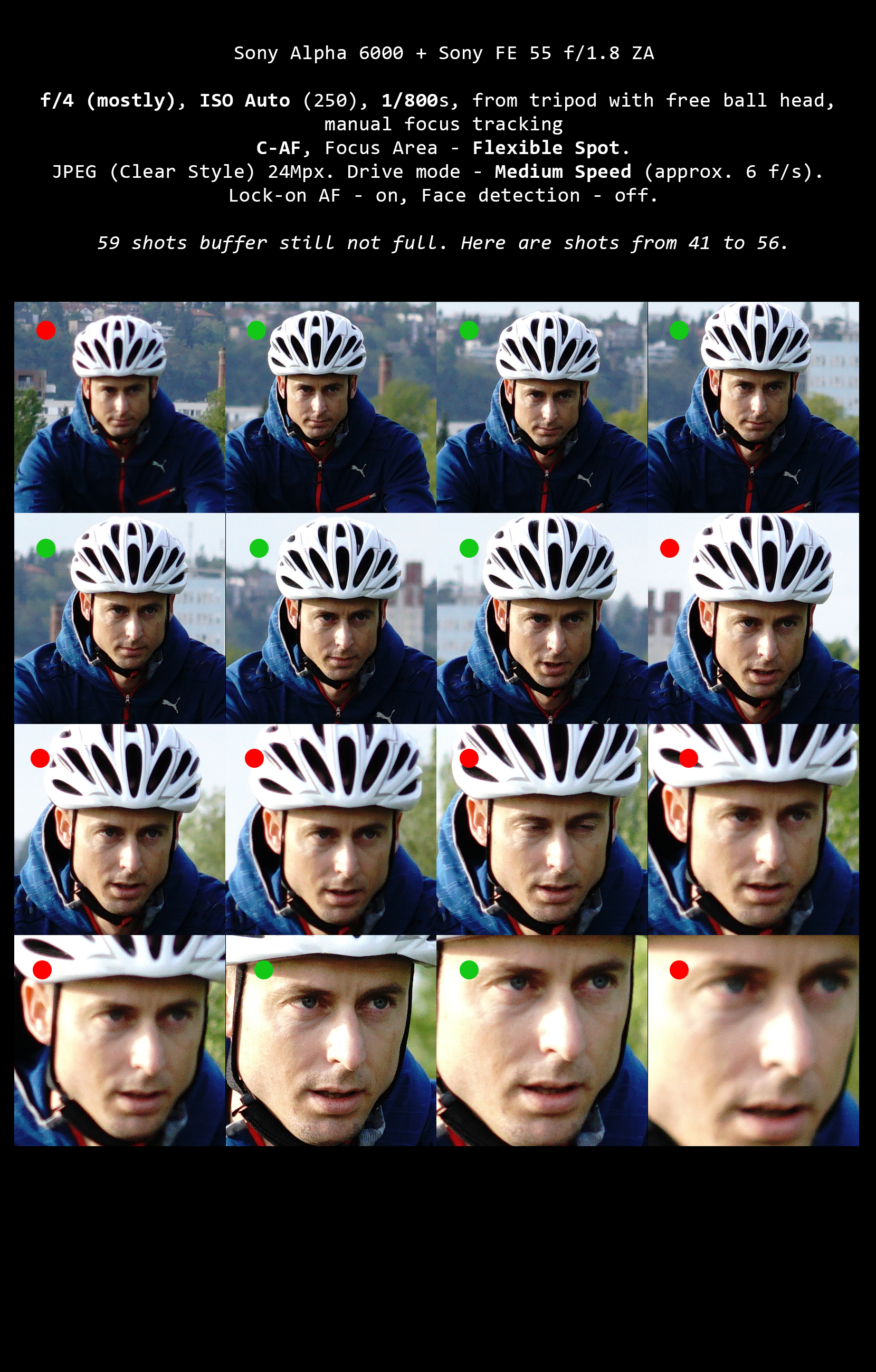
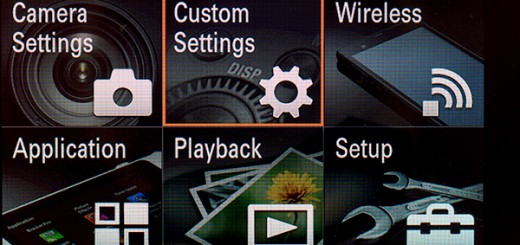
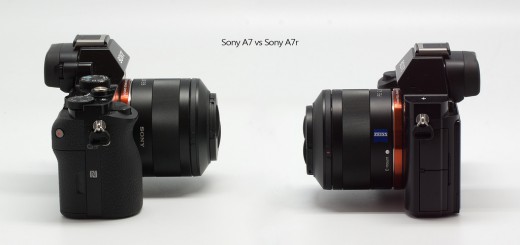
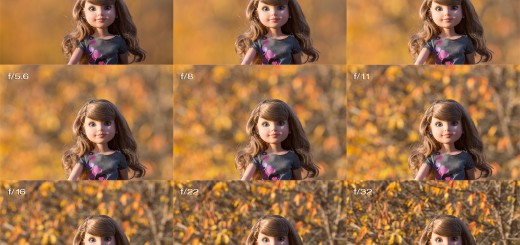













Good tests. If your objective is to test whether lock-on causes the camera to switch to contrast detection, I propose an experiment: use a subject that moves sideways (perpendicular to camera) and maintains the same distance. If lock-on uses phase detection, then this should be an easy test (because the distance is not changing) where most or all frames are in focus. If it uses contrast detection, then some shots will be in focus, and some will not be. What do you think?
Thank you for the suggestion. I am not sure that proposed test will work well because one of the main benefits of PDAF is that it gives 3D coordinates of the subject position. But of course, any controlled test will be good and I will try to do some more, once I receive FE 70-200 f/4 OSS.
Thanks for these tests, in my opinion you are being kind to this camera. I have been using pro DSLRs for fast action photography of very fast dogs (whippets) for over a decade and the A6000 isn’t good enough to even keep a human walking down the street in focus.
Ken
Victor,
I’m not sure why you aren’t using face detection in your testing. It seems that would be useful and provide for a real example AF shooting experience. It’s on by default on the camera and it should have provided more AF assistance in your examples.
Thanks for all your efforts.
Pat
Hi Pat,
In my previous post I tried face detection too, but there is also option with registered face detection, that I haven’t tried. Results (with face detection were completely out of focus apart from the first shot (apparently), so there was little reason to post them, but I think I wrote a note about it.
In general, Sony is using some relatively new “AF features” that have some analogy with traditional features such as shutter priority vs AF priority in the continuous shooting mode, but enhanced with the possibilities of the hybrid AF system. On DSLR, you can usually set (in the Continuous Drive mode and C-AF), if you like camera to fire, giving priority to (pre-selected or maximum) frame per second speed, while ignoring (to certain extent) if the focus is confirmed or not. Or you can set the AF priority, and regardless of the (pre-selected or maximum) frames per second, camera will wait (to certain extent, given by producers algorithm) to confirm the focus, before it fires. There are many reasons why would you like to use first or second option, but it will take me lot of space and time to go through it. To simplify it – imagine that you are shooting acrobat who is jumping across the stage (focus distance remains the same – perpendicular to camera), but you want to be sure that you will have as much as possible shots of the action to select the most exciting moment… In such situation, you will probably choose second option. If you are however somewhere in the curve, waiting for the runners, or bikers to come, and you know that they will run diagonally toward you, you would probably choose first option, because otherwise, most of your shots will be out of focus.
Sony face detection and probably focus lock-on function works a bit like that DSLRs focus priority setting, where (in theory), they will fire only when the focus is confirmed (on face or on locked-on subject, such as car, motorcycle, bird etc.), reducing thus camera drive speed.
Therefore, in some situation, you might be more successful with either face detection or focus lock-on, but in others, you will get better results with a plain C-AF and manual tracking.
When I selected in the above test – focus lock-on, I had results that more or less followed same pattern (with the subject at medium to close distance) 2 shots in focus, two shots back-focused, two shots in focus etc. This behavior is quite typical for CDAF, that can’t estimate distance of the subject from the lens, unlike with PDAF, that should be capable of predicting it. Even the best PDAF systems however (I shot with Canon 1Dx e.g. among others), are fooled sometimes when the subject moves fast toward or from camera, but there is no regularity in those failures unlike the ones I spotted here.
However, Sony could have used some hybrid AF algorithm for those situations, but that is something new for me and thus I can’t be certain about it.
I am pointing that out just to repeat what I already wrote in my post – that I wasn’t disappointed with A6000 AF performance in general. However in most situations in which I would know how to set most DSLRs to get best results within my capabilities, I am quite lost with Sony’s settings. In my comparison with Canon 1D MIII, I didn’t try to compare image quality of both camera/lens combination, but only tracking capability. I don’t mind overall little bit more blurry image from A6000, and as I wrote bellow that comparison, I was actually quite impressed with the results, because focus was mostly well locked across the burst. My settings recommendation – not to use focus lock-on (or face detection) are related to those or similar situations. If I will shot flying birds on the simplified background such as clear sky, flying rather perpendicular to the camera, flaying slower, or staying within reasonable DOF, I might rely on focus lock-on (but still have to see what difference makes two possible settings of that function). If I would shot kids playing in garden and I’d like to have mainly shots of my kid in focus, I would probably use registered face detection, and wouldn’t mind that I’d have 1,2 or 3 f/s instead of 6 or 11.
AF modes and features are designed in purpose to tell the dumb machine – what we want to keep in focus because they can’t read our minds. In the case of A6000, I would kindly ask Sony to first tell to dumb me – what modes and features should I use, to tell the camera what I want. And writing in their own AF specification description of the AF features (as posted above), in the very first line – “lock-on AF” and two words later “focus lock”, sounds confusing. Oh, I still haven’t get anywhere near “Eye focus” 🙂
Thanks for looking at my blog.
regards,
Viktor
Thank you for your time in doing so elaborate tests of focus speed with this camera. When I’ve tested it, I found the AF system a bit tricky, but fast indeed. I also observed the tendency to switch very often to contrast-detect instead of phase detect, which is a pity if you ask me. Actually, the only situation when camera uses phase detect focusing in my opinion is when using AF-C and Wide Area. I have also kept Face Detection to on, as suggested by Pat above, and I got lots of good results. But only with the kit lens, the 16-50 which also raised some questions and not so nice comments from some users :D.
Now I own the camera, in a final release version (not a sample like the one I’ve tested) and I’ll do more focusing test during my shootings.
Regards,
Alin Popescu
Thanks a lot Alin, especially for your great early review and for all effort that you put in sharing your findings with us.
I agree with you – as I wrote at the end of this post – maybe Sony is fastest AF camera today. It is however tricky claim to prove or deny, and it wouldn’t matter at all at the end of the day, if it won’t make some people unhappy, when they find their expectations to be false.
But again, I can’t and I don’t want to put anyone from buying this great little Sony camera, all I suggested is to read more, think a bit more and consider that they might not get plenty of keepers, without spending some time to learn and try different settings. And related to that, it would be really great if Sony publish a bit more explanatory instructions.
I am planning to do more controlled tests, asking one or two of my friends – pro sport photographers to try the camera and tell me their opinions, but I am waiting to get FE 70-200 f/4 OSS first and of course to find time to do so.
Thanks again for looking at my blog, have a great fun with your A6000 and looking forward to see more of yours great images and reviews.
Best regards,
Viktor
Hi,
I read your blog a few days ago and was quite surprised, because I`ve been using A6000 for about 3 weeks now and so far I´ve had no troubles with AF in burst mode. Only lens I have today is 16-50 and since you didn`t test it, I went out to do some tests myself. Camera settings were as follows: burst 11 fps, ISO400, shutter speed 1000 to 1500, fine jpg. I asked my subject to run diagonally towards me and used different AF settings each time (I didn`t test zone and flexible spot area). I just finished to check my results and they were more or less what I expected. Shots taken with wide and center area AF were 100% in focus as long as Lock-on AF was off. With both areas my subject fell out of focus quite soon after she started to run when Lock-on AF setting was on. I olso tested in-camera Action or Sports mode and again – 100% were in focus. Face detection didn`t seem to have impact on my result. Propably it needs some more testing under different circumstances but based on my results I can say that AF in 11fps burst mode works very well with 16-50 kit lens if Lock-on AF is not used.
Just a little remark: I orederd my A6000 after I finished reading Alin Popescus review 🙂
BR
Rait
Hi Rait and thanks for your comment. I am glad that it works for you and that is certainly most important. To be able to comment on your findings, I would need to see 100% crops from RAW, unsharpened in pp and to see exact settings, such as FL used, aperture, distance from subject etc. All that can significantly affect results. If the subject was further and if you selected FL at approx. 35mm e.g. and aperture was f/8 or smaller, you might get almost everything at selected distance to infinity in focus, due to the large DOF. That is why. i am waiting for 70-200 f/4 OSS, tontest AF tracking with a pro lens that is supposed to be used for sport and action at a distance. But as I said at the begining, if it works for you, that’s what really matters.
I used 50 mm and widest aperture availeable. Subject moved towards me from filling the half of the frame until only upper body fit into frame. It works for me now but I`m certainly not going to stick only with kit lens. My next buy is sony 30 f1,8 so lets see what happens then.
Rait
Hi Viktor,
Sorry to chime in so late, but I agree with you that those AF modes take some time to get to grips with.
AFAIK, the zone-, F-tracking and Face Detection are modes independent of each other and seem to override each other. From my own experience (I have a7) it seems to rank faces highest, tracked objects second and last resort is zone AF. Sony’s own descriptions do not help much. So far best explanation I’ve seen (of any alpha camera), are the e-books by Gary Friedman. In November 2014 he also released an explanatory video on YT:
https://www.youtube.com/watch?v=306xXWy7Izw
From all info I gather, Sony needs to hit focus with CDAF first, and uses PDAF only in AF-C mode to track the subject. My own small test with a7II and FE 70-200 G show similar results – the camera occasionally loses focus, but then recovers:
https://www.flickr.com/photos/priitv8/15854896523/in/set-72157650156249089
Thanks for all thoughts and links. Much appreciated.
Cheers,
Viktor